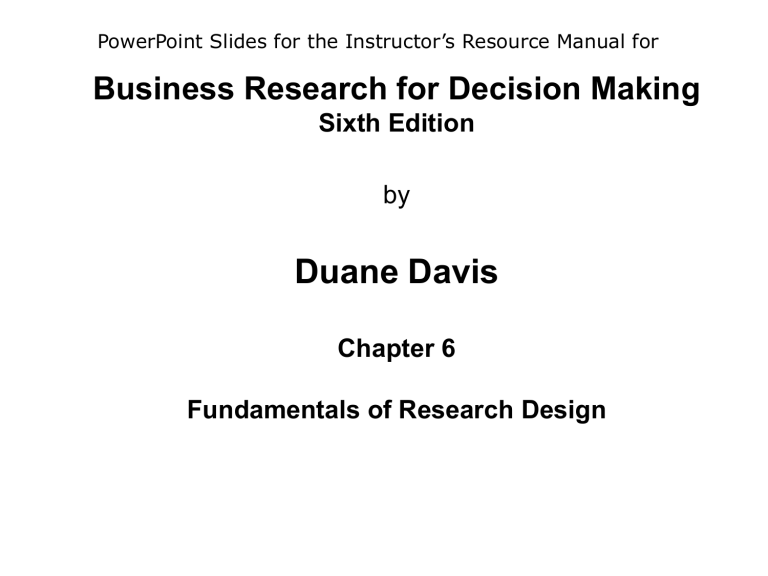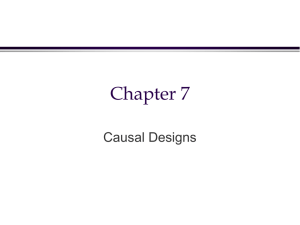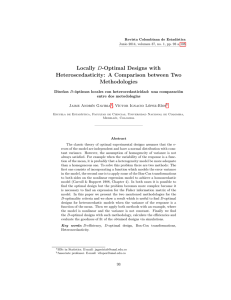Business Research for Decision Making Sixth Edition

PowerPoint Slides for the Instructor’s Resource Manual for
Business Research for Decision Making
Sixth Edition by
Duane Davis
Chapter 6
Fundamentals of Research Design
Research Design
Is the structure of the research project to solve a particular problem?
Its purpose is to guide researchers in answering problems.
Is a series of tradeoffs and compromises.
Potential Sources of Error in the Design Process:
1. Planning – faulty designs
2. Collection – actual collection of data
3. Analytical – the way the data is analyzed
4. Reporting- errors in interpretation
MaxiMinCon Principle
• Researchers are guided by the MaxiMinCon Principle
Maximize systematic variance
Minimize error variance
Control extraneous variance
Design is the researcher’s attempt at variance control.
MaxiMinCon Principle, continued
• Four Primary Means to Control Variance
1. Build the variable into the study
2. Exclude the variable from the study
3. Statistically control the variable(s) through covariance analysis
4. Randomization
Table 6.1
Potential Sources of Error in the
Research Design Process
Managerial Strategies for Dealing with
Error
• Planning Error - well thought out proposals that are specific in design aspects – evaluated impartially
• Collection Error – careful execution of planned design – periodic managerial evaluations
• Analytical Error – justification of analytical methods – outside evaluation
• Reporting Error – unbiased and knowledgeable reviewers – commonplace in rigorous research environments
Figure 6.1
Schematic
Diagrams
Illustrating
Moderation &
Intervening
Variables
Source: Adapted from Uma Sekaran,
Research Methods for Managers
(New York: Wiley, 1984), pp. 50–58.
Internal Validity
Are the results of the study true?
Is what has taken place due to the variables the researcher claims to be operating or could something else have taken place?
Internal Validity
• History : events outside the study affect the results. E.g. high unemployment
• Maturation : changes in respondents over time
• Testing : halo effect, Hawthorne effect – are the respondents tipped about what your are studying?
• Instrumentation : changes in the instrument over time.
• Selection : differences among groups; respondents vs. non-respondents
• Mortality : people drop out of a study over time
External Validity
What is causality and proof?
Can anything be proven?
Causality
• Theory – a reason why one variable should cause an effect in another
• Correlation
• Time order: cause MUST proceed effect
• Rule out other explanations for the effect or spurious variables
Table 6.2
Comparison of the Major Types of Research
Designs
©2005 by Duxbury
A division of Thomson Learning
Table 6.3
Sources of Invalidity for Basic Research Designs*
Source: Donald T. Campbell and Julian C. Stanley: Experimental and Quasi-Experimental Designs for
Research, copyright © 1963, Houghton Mifflin Company, used by permission.
R - Randomly
A - Assign to conditions of
I - Independent variable, then observe on
D - Dependent variable, for
E- Experimental
R - Research
major research methods tend to have strengths, as well as weaknesses.
Ability to
Represent
Real-life
Situations
(EXTERNAL
VALIDITY)
Low
High
Ability to Infer
Causality
(INTERNAL VALIDITY)
Low
SURVEYS
High
EXPERIMENTS
This would be the ideal
– strong in both areas
Managerial Concerns
• No single correct design
• Design to answer the research problem
• All research design represents a compromise
• A design is not a framework to be followed blindly
Key Managerial Questions Pertaining to
Research Design









